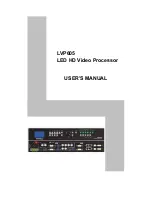
SECTION 5– (cont.)
Figure 5-6: Check knife gap with feeler gauges. Figure 5-7: Rotate new bearings to properly seat.
Figure 5-8: Bend lock washer tab into place. Figure 5-9: Bend front lock washer tab into place.
Rotate knives by each other and check knife gap using feeler gauges (Figure 5-6). Tightening the rear
lock nut should have pulled the rotating knife away from the stationary knife. The knife gap should be
GREATER THAN .002”-.005”. This allows room to tighten the front lock nut in the next step.
NOTE: If new bearings are being used, at this point the rotating knife holder should be ro-
tated 20-30 revolutions, in each direction, to properly seat the bearings.
Tighten the front lock nut again to pull the rotating knife holder BACK TOWARD THE STATIONARY
KNIFE. This should require approximately 180-220 lb-ft of torque.
NOTE: Torque required is approximate. The purpose of alternating tightening of the lock
nuts is to preload the housing and bearings. This preloading prevents the rotating knife
holder from moving away from the stationary knife when chopping material. A good way to
check for proper bearing preload is to spin the flywheel after it has been installed. The fly-
wheel should not rotate more than one full revolution before stopping.
Final knife gap should be .002”-.005”. If the knife gap still exceeds .002”-.005” after apply
approximately 220 lb-ft of torque to the front lock nut, loosen the rear lock nut slightly and repeat the
above steps.


































